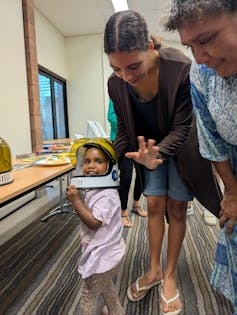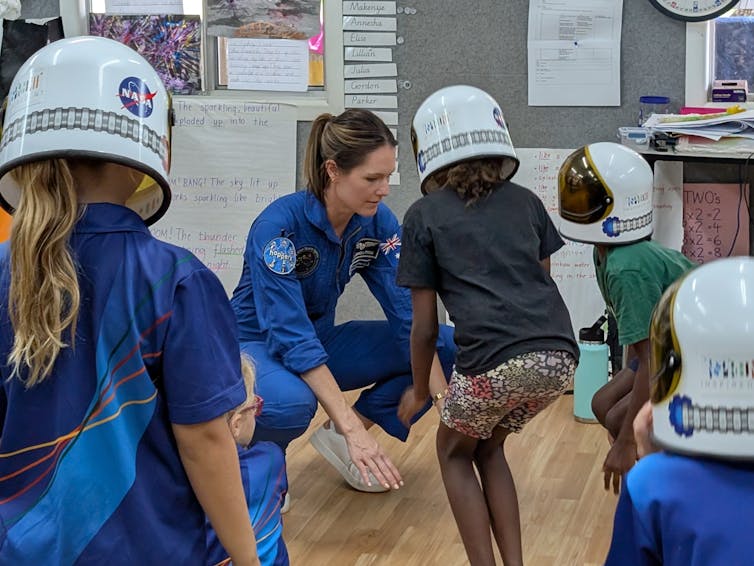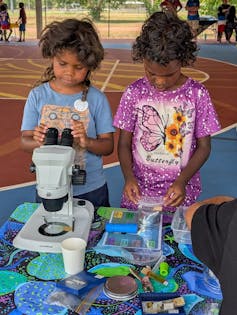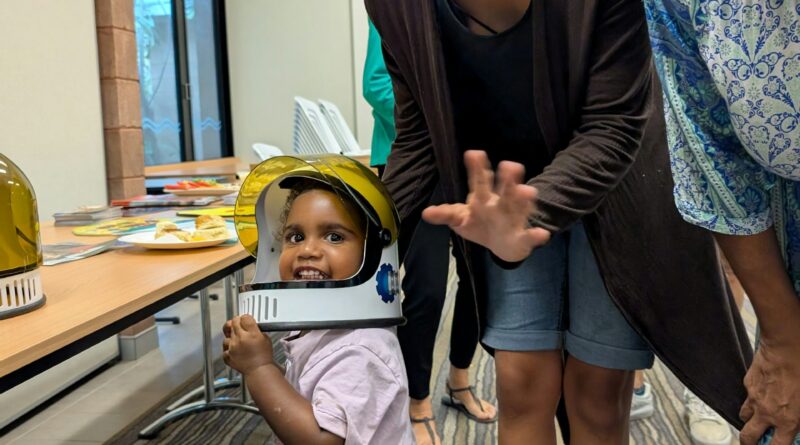An annual roadshow is helping kids from remote Australia realise their dreams of becoming a scientist
“Miss, miss, can I play with your robot?”
The question comes from a young local school girl standing in front of our stall at Barunga Festival, 80 kilometres southeast of Katherine in the Northern Territory. She points at our broken robot. We are hot, tired and getting ready to pack up, and explain to her that it is no longer working.
She insists she would like to play with it anyway. So we concede. In five minutes, she has fixed it and returns a fully functional robot.
Not for the first time, we wonder about the new discoveries and innovations humanity is missing out on because remote and rural children are not given genuine opportunities to engage and follow careers in science, technology, engineering and mathematics (STEM).
For the past four years, we have been on the road with STEM outreach in remote communities. We have recently returned home from this year’s trip. Our work shows these children don’t have to miss out.
Fewer opportunities
STEM skills are becoming core competencies for most job types and are identified as a key tool for long-term economic growth and global competitiveness.
Australia will need 312,000 additional technology workers by 2030 to meet industry demand.
Filling this gap is made harder by the fact that in Australia, 15-year-old students from remote areas lag behind in science by an average of 1.5 years, compared to those from metropolitan areas. They also perform significantly below the international average in mathematics.
A major factor responsible for this is that remote students have fewer career and education opportunities, poorer access to resources and a fragmented network of contacts for career advice.
It is also harder for rural and remote schools to obtain staff who are adequately qualified to teach STEM subjects. Remote children don’t have access to the same STEM experiences as city kids, who can visit their local – and large – science museums. For remote children, even basic activities such as the classic volcano experiment (using baking soda and vinegar) can be a novelty.
But this does not indicate a lack of talent for STEM.
A full day STEM extravaganza
We have worked on STEM engagement and outreach in remote areas of the Amazon, Papua New Guinea, Timor-Leste and northern Australia.
For the past four years, our Radicle Centre team from Charles Darwin University has been delivering STEM engagement and outreach to remote and rural communities and schools in the Northern Territory. During our roadshow, undergraduate and postgraduate students from STEM fields join our crew, sharing their passion for science and technology.

Our roadshow has visited the same schools since 2020. Each year, we offer STEM workshops that are contextualised to students’ experiences and environment. For example, the workshops usually portray fauna, flora and stories from the Northern Territory.
It is a full school day STEM extravaganza! In 2024, we engaged with over 400 children from nine remote and rural schools and communities in the Northern Territory.
These kinds of outreach programs can play an important role in rural and remote areas by building, supporting, and maintaining STEM capability – provided they recognise, respect, and tailor their content to the local context.
Teachers welcome our visits, as in most cases there are very few opportunities for STEM activities at their schools.
Despite this lack of opportunity, many children who live in these parts of the world seem to have a knack for science and technology. From a wind-powered Christmas tree complete with lights created by school students in the Kikori Region of Papua New Guinea, to a super-fast miniature solar car designed by two school students from the Northern Territory – we are consistently wowed by the talent in remote regions.

A holistic approach is needed
Many children we have met every year confidently tell us they would like to become scientists, engineers or IT professionals. Which leads to a complex question: what is next for them?
Fewer rural and remote students attend university than those living in cities. And those who leave home to attend university face financial, personal and social challenges.
To truly support remote students who are undertaking university STEM courses, there is a need for a more holistic approach.
In Brazil, for example, university students from remote locations are offered a full assistance package that includes free accommodation and meals at university, as well as a stipend, and social and psychological support. Such approaches are few and far between in Australia.

Building an inclusive STEM workforce requires a long-term commitment from individuals, industry and the government.
Diversity drives innovation. The lack of support for rural and remote students to follow careers in STEM has wide implications.
It can be personally devastating for those that have potential but were never given the chance to develop it. But it also comes at a high cost to our society, which is deprived of a diverse STEM workforce and consequently will never benefit from the discoveries and innovations that our remote youth could make, if given the opportunity.

